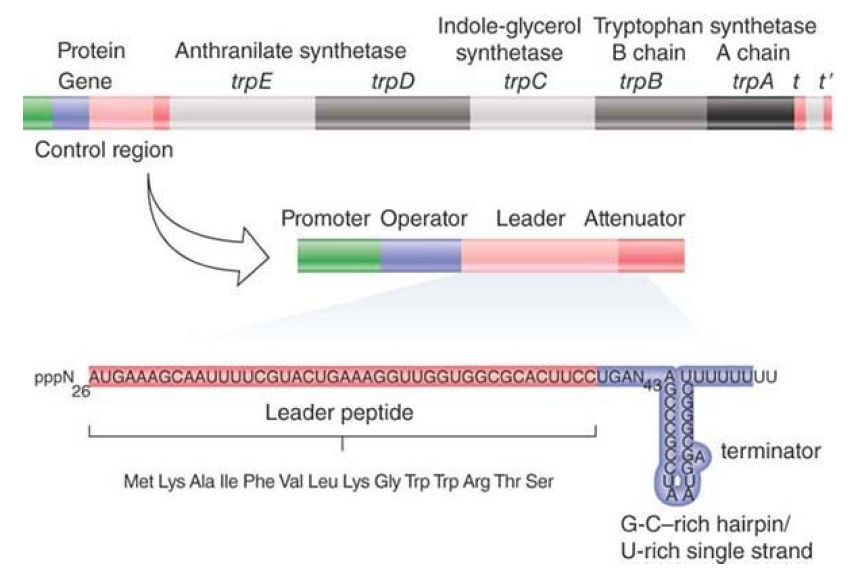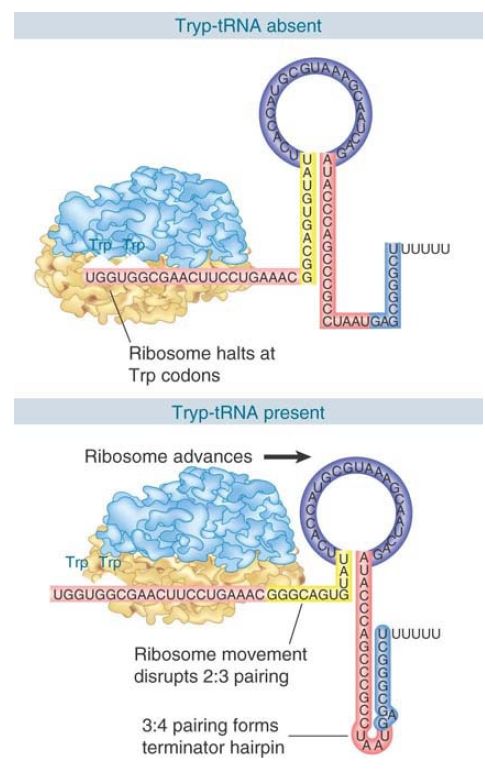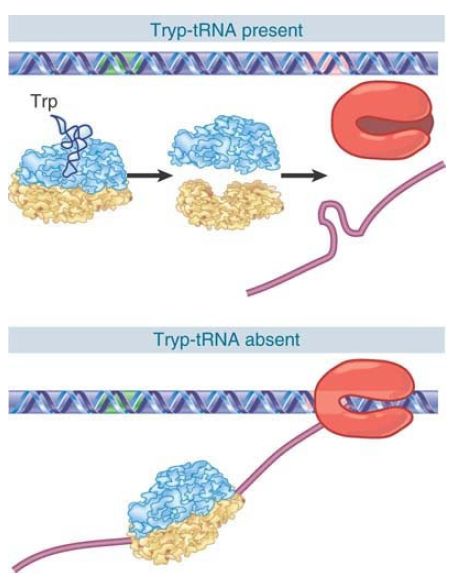


 النبات
النبات
 الحيوان
الحيوان
 الأحياء المجهرية
الأحياء المجهرية
 علم الأمراض
علم الأمراض
 التقانة الإحيائية
التقانة الإحيائية
 التقنية الحيوية المكروبية
التقنية الحيوية المكروبية
 التقنية الحياتية النانوية
التقنية الحياتية النانوية
 علم الأجنة
علم الأجنة
 الأحياء الجزيئي
الأحياء الجزيئي
 علم وظائف الأعضاء
علم وظائف الأعضاء
 الغدد
الغدد
 المضادات الحيوية
المضادات الحيوية|
Read More
Date: 1-1-2021
Date: 9-5-2021
Date: 13-12-2015
|
Attenuation Can Be Controlled by Translation
KEY CONCEPTS
- The leader region of the trp operon has a 14-codon open reading frame that includes two codons for tryptophan.
- The structure of RNA at the attenuator depends on whether this reading frame is translated.
- In the presence of Trp-tRNA, the leader is translated,and the attenuator is able to form the hairpin that causes termination.
- In the absence of Trp-tRNA, the ribosome stalls at the tryptophan codons and an alternative secondary structure prevents formation of the hairpin, so that transcription continues.
How can termination of transcription at the attenuator respond to the level of Trp-tRNA? The sequence of the leader region suggests a mechanism. It has a short open reading frame that codes for a leader peptide of 14 amino acids. FIGURE 1shows that it contains a ribosome-binding site whose AUG codon is followed by a short coding region that contains two successive codons for tryptophan. When the cell has a low level of Trp-tRNA, ribosomes initiate translation of the leader peptide but stop when they reach the Trp codons. The sequence of the mRNA suggests that this ribosome stalling influences termination at the attenuator.

FIGURE 1. The trp operon has a short sequence coding for a leader peptide that is located between the operator and the attenuator.
The leader sequence can be written in alternative base-paired structures. The ability of the ribosome to proceed through the leader region controls transitions between these structures. The structure determines whether the mRNA can provide the features needed for termination.
FIGURE 2 shows these structures. In the first, region 1 pairs with region 2 and region 3 pairs with region 4. The pairing of regions 3 and 4 generates the hairpin that precedes the U8 sequence: This is the essential signal for intrinsic termination. It is likely that the RNA would form this structure automatically.

FIGURE 2. The trp leader region can exist in alternative basepaired conformations. The center shows the four regions that can base pair. Region 1 is complementary to region 2, which is complementary to region 3, which is complementary to region 4. On the left is the conformation produced when region 1 pairs with region 2 and region 3 pairs with region 4. On the right is the conformation when region 2 pairs with region 3, leaving regions 1 and 4 unpaired.
A different structure is formed if region 1 is prevented from pairing with region 2. In this case, region 2 is free to pair with region 3. Region 4 then has no available pairing partner, so it is compelled to remain single stranded. Thus, the terminator hairpin cannot be formed.
FIGURE 3 shows that the position of the ribosome can determine which structure is formed in such a way that termination is attenuated only when Trp-tRNA levels are low. The crucial feature is the position of the Trp codons in the leader peptide–coding sequence.

FIGURE 3. The alternatives for RNA polymerase at the attenuator depend on the location of the ribosome, which determines whether regions 3 and 4 can pair to form the terminator hairpin.
When Trp-tRNA is abundant, ribosomes are able to synthesize the leader peptide. They continue along the leader section of the mRNA to the UGA codon, which lies between regions 1 and 2. As shown in the lower part of the figure, by progressing to this point the ribosomes extend over region 2 and prevent it from base pairing. The result is that region 3 is available to base pair with region 4, which generates the terminator hairpin. Under these conditions, therefore, RNA polymerase terminates at the attenuator.
When Trp-tRNA is not abundant, ribosomes stall at the Trp codons, which are part of region 1, as shown in the upper part of the figure. Thus, region 1 is sequestered within the ribosome and cannot base pair with region 2. This means that regions 2 and 3 become base paired before region 4 has been transcribed. This compels region 4 to remain in a single-stranded form. In the absence of the terminator hairpin, RNA polymerase continues transcription past the attenuator.
Control by attenuation requires a precise timing of events. For ribosome movement to determine formation of alternative secondary structures that control termination, translation of the leader must occur at the same time that RNA polymerase approaches the terminator site. A critical event in controlling the timing is the presence of a site that causes the RNA polymerase to pause at base 90 along the leader. The RNA polymerase remains paused until a ribosome translates the leader peptide. The polymerase is then released and moves off toward the attenuation site. By the time it arrives there, the secondary structure of the attenuation region has been determined.
FIGURE 4 illustrates the role of Trp-tRNA in controlling expression of the operon. By providing a mechanism to sense the abundance of Trp-tRNA, attenuation responds directly to the need of the cell for tryptophan in protein synthesis.

FIGURE 4. In the presence of tryptophan tRNA, ribosomes translate the leader peptide and are released. This allows hairpin formation, so that RNA polymerase terminates. In the absence of tryptophan tRNA, the ribosome is blocked, the termination hairpin cannot form, and RNA polymerase continues.
How widespread is the use of attenuation as a control mechanism for bacterial operons? It is used in at least six operons that code for enzymes concerned with the biosynthesis of amino acids. Thus, a feedback from the level of the amino acid available for protein synthesis (as represented by the availability of aminoacyl-tRNA) to the production of the enzymes may be common. The use of the ribosome to control RNA secondary structure in response to the availability of an aminoacyl-tRNA establishes an inverse relationship between the presence of aminoacyl-tRNA and the transcription of the operon, which is equivalent to a situation in which aminoacyl-tRNA functions as a corepressor of transcription.
The regulatory mechanism is mediated by changes in the formation of duplex regions; thus, attenuation provides a striking example of the importance of secondary structure in the termination event and of its use in regulation.
E. coli and Bacillus subtilis use the same types of mechanisms, which involve control of mRNA structure in response to the presence or absence of an aminoacyl tRNA, but they have combined the individual interactions in different ways. The end result is the same: to inhibit production of the enzymes when there is an excess supply of the amino acid and to activate production when a shortage is indicated by the accumulation of uncharged tRNATrp .



|
|
|
|
للعاملين في الليل.. حيلة صحية تجنبكم خطر هذا النوع من العمل
|
|
|
|
|
|
|
"ناسا" تحتفي برائد الفضاء السوفياتي يوري غاغارين
|
|
|
|
|
|
|
شعبة فاطمة بنت أسد (عليها السلام) تنظم دورة تخصصية في أحكام التلاوة
|
|
|